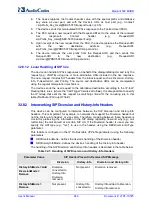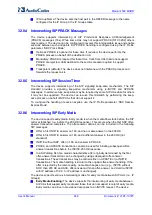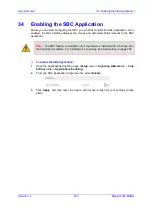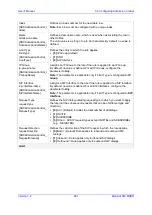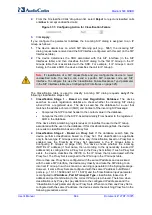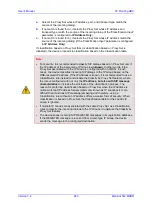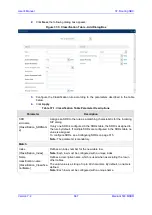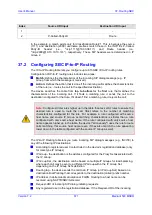
Version 7.2
659
Mediant 500 MSBR
User's Manual
36. Configuring Admission Control
36
Configuring Admission Control
The Admission Control table lets you configure up to 102 Call Admission Control rules
(CAC). CAC rules define the maximum number of concurrent calls (SIP dialogs) permitted
per IP Group, SIP Interface or SRD, and per user (identified by its registered contact). CAC
rules also define a guaranteed (
reserved
) number of concurrent calls. Thus, CAC rules can
be useful for implementing Service Level Agreements (SLA) policies. CAC rules are also
especially important for applications where VoIP and Data traffic contend on the WAN
throughput, which may be limited by itself. For example, DSL WAN access interface is very
limited in the uplink. By controlling the number of permitted calls, bandwidth can be
reserved for specific Data applications.
CAC rules can be applied per SIP request type and SIP dialog direction (inbound and/or
outbound). These relate to requests that initiate SIP dialogs and not the subsequent
requests that can be of different type and direction. The SIP dialog-initiating request types
can include INVITE, REGISTER, and/or SUBSCRIBE messages, or it can be configured to
include the total number of all dialogs.
This feature also provides support for SIP-dialog rate control, using the “token bucket”
mechanism. The token bucket is a control mechanism that dictates the rate of SIP-dialog
setups based on the presence of tokens in the bucket – a logical container that holds
aggregate SIP dialogs to be accepted or transmitted. Tokens in the bucket are removed
("cashed in") for the ability to setup a dialog. Thus, a flow can setup dialogs up to its peak
burst rate if there are adequate tokens in the bucket and if the burst threshold is configured
appropriately:
Every SIP dialog setup request must attempt to take a token from the bucket.
If there are no tokens, the request is dropped.
New tokens are added to the bucket at a user-defined rate (token rate).
If the bucket contains the maximum number of tokens, tokens to be added at that
moment are dropped.
Reserved capacity is especially useful when the device operates with multiple SIP entities
such as in a contact center environment handling multiple customers. For example, if the
total call capacity of the device is 200 call sessions, a scenario may arise where one SIP
entity may reach the maximum configured call capacity of 200 and thereby, leaving no
available call resources for the other SIP entities. Thus, reserved capacity guarantees a
minimum capacity for each SIP entity. If the reserved call capacity of a SIP entity is
threatened by a new call for a different SIP entity, the device rejects the call to safeguard
the reserved capacity.
Reserved call capacity can be configured for an SRD and each of its associated IP Groups,
by configuring multiple CAC rules. In such a setup, the SRD's reserved call capacity must
be greater or equal to the summation of the reserved call capacity of all these IP Groups. In
other words, the SRD serves as the "parent" reserved call capacity. If the SRD's reserved
call capacity is greater, the extra call capacity can be used as a shared pool between the
IP Groups for unreserved calls when they exceed their reserved capacity. For example,
assume that the reserved capacities for an SRD and its associated IP Groups are as
follows:
SRD reserved call capacity: 40
IP Group ID 1 reserved call capacity: 10
IP Group ID 2 reserved call capacity: 20
In this setup, the SRD offers a shared pool for unreserved call capacity of 10 [i.e., 40 – (10
+ 20)]. If IP Group ID 1 needs to handle 15 calls, it is guaranteed 10 calls and the
remaining 5 is provided from the SRD's shared pool. If the SDR's shared pool is currently
empty and resources for new calls are required, the quota is taken from the device's total
capacity, if available. For example, if IP Group ID 1 needs to handle 21 calls, it's
Summary of Contents for Mediant 500 MSBR
Page 2: ......
Page 33: ...Part I Getting Started with Initial Connectivity ...
Page 34: ......
Page 36: ...User s Manual 36 Document LTRT 10375 Mediant 500 MSBR This page is intentionally left blank ...
Page 40: ...User s Manual 40 Document LTRT 10375 Mediant 500 MSBR This page is intentionally left blank ...
Page 45: ...Part II Management Tools ...
Page 46: ......
Page 48: ...User s Manual 48 Document LTRT 10375 Mediant 500 MSBR This page is intentionally left blank ...
Page 115: ...Part III General System Settings ...
Page 116: ......
Page 132: ...User s Manual 132 Document LTRT 10375 Mediant 500 MSBR This page is intentionally left blank ...
Page 137: ...Part IV General VoIP Configuration ...
Page 138: ......
Page 290: ...User s Manual 290 Document LTRT 10375 Mediant 500 MSBR This page is intentionally left blank ...
Page 306: ...User s Manual 306 Document LTRT 10375 Mediant 500 MSBR This page is intentionally left blank ...
Page 380: ...User s Manual 380 Document LTRT 10375 Mediant 500 MSBR This page is intentionally left blank ...
Page 454: ...User s Manual 454 Document LTRT 10375 Mediant 500 MSBR This page is intentionallty left blank ...
Page 455: ...Part V Gateway Application ...
Page 456: ......
Page 460: ...User s Manual 460 Document LTRT 10375 Mediant 500 MSBR This page is intentionally left blank ...
Page 484: ...User s Manual 484 Document LTRT 10375 Mediant 500 MSBR This page is intentionally left blank ...
Page 494: ...User s Manual 494 Document LTRT 10375 Mediant 500 MSBR This page is intentionally left blank ...
Page 625: ...Part VI Session Border Controller Application ...
Page 626: ......
Page 654: ...User s Manual 654 Document LTRT 10375 Mediant 500 MSBR This page is intentionally left blank ...
Page 656: ...User s Manual 656 Document LTRT 10375 Mediant 500 MSBR This page is intentionally left blank ...
Page 741: ...Part VII Cloud Resilience Package ...
Page 742: ......
Page 751: ...Part VIII Data Router Configuration ...
Page 752: ......
Page 753: ......
Page 754: ......
Page 756: ...User s Manual 756 Document LTRT 10375 Mediant 500 MSBR This page is intentionally left blank ...
Page 757: ...Part IX Maintenance ...
Page 758: ......
Page 834: ...User s Manual 834 Document LTRT 10375 Mediant 500 MSBR This page is intetnionaly left blank ...
Page 837: ...Part X Status Performance Monitoring and Reporting ...
Page 838: ......
Page 848: ...User s Manual 848 Document LTRT 10375 Mediant 500 MSBR This page is intentionally left blank ...
Page 852: ...User s Manual 852 Document LTRT 10375 Mediant 500 MSBR This page is intentionally left blank ...
Page 854: ...User s Manual 854 Document LTRT 10375 Mediant 500 MSBR This page is intentionally left blank ...
Page 878: ...User s Manual 878 Document LTRT 10375 Mediant 500 MSBR This page is intentionally left blank ...
Page 880: ...User s Manual 880 Document LTRT 10375 Mediant 500 MSBR This page is intentionally left blank ...
Page 926: ...User s Manual 926 Document LTRT 10375 Mediant 500 MSBR This page is intentionally left blank ...
Page 927: ...Part XI Diagnostics ...
Page 928: ......
Page 950: ...User s Manual 950 Document LTRT 10375 Mediant 500 MSBR This page is intentionally left blank ...
Page 954: ...User s Manual 954 Document LTRT 10375 Mediant 500 MSBR This page is intentionally left blank ...
Page 956: ...User s Manual 956 Document LTRT 10375 Mediant 500 MSBR This page is intentionally left blank ...
Page 958: ...User s Manual 958 Document LTRT 10375 Mediant 500 MSBR This page is intentionally left blank ...
Page 974: ...User s Manual 974 Document LTRT 10375 Mediant 500 MSBR This page is intentionally left blank ...
Page 976: ...User s Manual 976 Document LTRT 10375 Mediant 500 MSBR This page is intentionally left blank ...
Page 977: ...Part XII Appendix ...
Page 978: ......
Page 982: ...User s Manual 982 Document LTRT 10375 Mediant 500 MSBR This page is intentionally left blank ...


